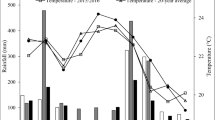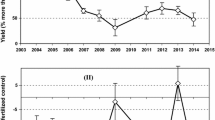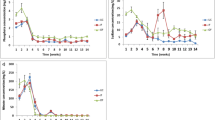Abstract
We studied the effect of five fertilizers (including two adjusted manure slurries) and an untreated control on soil biota and explored the effect on the ecosystem services they provided. Our results suggest that the available N (NO −3 and NH +4 ) in the soil plays a central role in the effect of fertilizers on nematodes and microorganisms. Microorganisms are affected directly through nutrient availability and indirectly through grass root mass. Nematodes are affected indirectly through microbial biomass and grass root mass. A lower amount of available N in the treatment with inorganic fertilizer was linked to a higher root mass and a higher abundance and proportion of herbivorous nematodes. A higher amount of available N in the organic fertilizer treatments resulted in a twofold higher bacterial activity (measured as bacterial growth rate, viz. thymidine incorporation), a higher proportion of bacterivorous nematodes, a 30% higher potential N mineralization (aerobic incubation), and 25–50% more potentially mineralizable N (anaerobic incubation). Compared to inorganic fertilizer, organic fertilization increased the C total, the N total, the activity of decomposers, and the supply of nutrients via the soil food web. Within the group of organic fertilizers, there was no significant difference in C total, abundances of soil biota, and the potential N mineralization rate. There were no indications that farmyard manure or the adjusted manure slurries provided the ecosystem service “supply of nutrients” better than normal manure slurry. Normal manure slurry provided the highest bacterial activity and the highest amount of mineralizable N and it was the only fertilizer resulting in a positive trend in grass yield over the years 2000–2005. The number of earthworm burrows was higher in the treatments with organic fertilizers compared to the one with the inorganic fertilizer, which suggests that organic fertilizers stimulate the ecosystem service of water regulation more than inorganic fertilizer. The trend towards higher epigeic earthworm numbers with application of farmyard manure and one of the adjusted manure slurries, combined with the negative relation between epigeic earthworms and bulk density and a significantly lower penetration resistance in the same fertilizer types, is preliminary evidence that these two organic fertilizer types contribute more to the service of soil structure maintenance than inorganic fertilizer.



Similar content being viewed by others
References
Alphei J, Bonkowski M, Scheu S (1996) Protozoa, Nematoda and Lumbricidae in the rhizosphere of Hordlymus europaeus (Poaceae): faunal interactions, response of microorganisms and effects on plant growth. Oecologia 106:111–126
Bardgett RD, Keiller S, Cook R, Gilburn AS (1998) Dynamic interactions between soil animal and microorganisms in upland grassland soils amended with sheep dung: a microcosm experiment. Soil Biol Biochem 30:531–539. doi:10.1016/S0038-0717(97) 00146-6
Bardgett RD, Mawdsley JL, Edwards S, Hobbs PJ, Rodwell JS, Davies WJ (1999) Plant species and nitrogen effect on soil biological properties of temperate upland grasslands. Funct Ecol 13:650–660. doi:10.1046/j.1365-2435.1999.00362.x
Birkhofer K, Bezemer TM, Bloem J, Bonkowski M, Christensen S, Dubois D, Ekelund F, Fließbach A, Gunst L, Hedlund K, Mäder P, Mikola J, Robin C, Setäla H, Tatin-Froux F, Van der Putten WH, Scheu S (2008) Long-term organic farming fosters below and aboveground biota: implications for soil quality, biological control and productivity. Soil Biol Biochem 40:2297–2308. doi:10.1016/j.soilbio.2008.05.007
Bittman S, Forge TA, Kowalenko CG (2005) Response of the bacterial and fungal biomass in a grassland soil to multi-year applications of dairy manure slurry and fertilizer. Soil Biol Biochem 37:613–623. doi:10.1016/j.soilbio.2004.07.038
Bloem J, Bolhuis PR (2006) Thymidine and leucine incorporation to assess bacterial growth rate. In: Bloem J, Hopkins DW, Benedetti A (eds) Microbiological methods for assessing soil quality. CABI, Wallingford, UK, pp 142–149
Bloem J, Vos A (2004) Fluorescent staining of microbes for total direct counts. In: Kowalchuk GA, De Bruijn FJ, Head IM, Akkermans ADL, Van Elsas JD (eds) Molecular microbial ecology manual, 2nd edn. Kluwer Academic Publishers, Dordrecht, pp 861–874
Bloem J, Lebbink G, Zwart KB, Bouwman LA, Burgers SLGE, de Vos JA, de Ruiter PC (1994) Dynamics of microbes, microbivores and nitrogen mineralization in winter wheat fields under conventional and integrated management. Agric Ecosyst Environ 51:129–143. doi:10.1016/0167-8809(94) 90039-6
Bloem J, Veninga M, Shepherd J (1995) Fully automatic determination of soil bacterium numbers, cell volumes and frequencies of dividing cells by confocal laser scanning microscopy and image analysis. Appl Environ Microbiol 61:926–936
Bloem J, Schouten AJ, Sørensen SJ, Rutgers M, van der Werf A, Breure AM (2006) Monitoring and evaluating soil quality. In: Bloem J, Hopkins DW, Benedetti A (eds) Microbiological methods for assessing soil quality. CABI, Wallingford, UK, pp 23–49
Bongers T (1990) The maturity index: an ecological measure of environmental disturbance based on nematode species composition. Oecologia 83:14–19. doi:10.1007/BF00324627
Bongers T, De Goede RGM, Korthals GW, Yeates GW (1995) Proposed changes of c-p classification for nematodes. Russ J Nematol 3:61–62
Bouché MB (1977) Strategies lombriciennes. In: Lohm U, Persson T (eds) Soil organisms as components of ecosystems. Ecol Bull 25:122-132
Bouché MB, Al-Addan F (1997) Earthworms, water infiltration and soil stability: some new assessments. Soil Biol Biochem 29:441–452. doi:10.1016/S0038-0717(96) 00272-6
Bouwman LA, Arts WBM (2000) Effects of soil compaction on the relationships between nematodes, grass production and soil physical properties. Appl Soil Ecol 14:213–222. doi:10.1016/S0929-1393(00) 00055-X
Brussaard L, Behan-Pelletier VM, Bignell DE, Brown VK, Didden WAM, Folgarait PJ, Fragoso C, Freckman DW, Gupta VVSR, Hattori T, Hawksworth DL, Klopatek C, Lavelle P, Walloch D, Rusek J, Söderström B, Tiedje JM, Virginia RA (1997) Biodiversity and ecosystem functioning in soil. Ambio 26:563–570
Brussaard L, de Ruiter PC, Brown GG (2007a) Soil biodiversity for agricultural sustainability. Agric Ecosyst Environ 121:233–244. doi:10.1016/j.agee.2006.12.013
Brussaard L, Pulleman MM, Ouédraogo E, Mando A, Six J (2007b) Soil fauna and soil function in the fabric of the food web. Pedobiologia (Jena) 50:447–462. doi:10.1016/j.pedobi.2006.10.007
Canali S, Benedetti A (2006) Soil nitrogen mineralization. In: Bloem J, Hopkins DW, Benedetti A (eds) Microbiological methods for assessing soil quality. CABI, Wallingford, UK, pp 127–135
Clements RO, Murray PJ, Sturdy RG (1991) The impact of 20 years' absence of earthworms and three levels of N fertilizers on a grassland environment. Agric Ecosyst Environ 36:75–85. doi:10.1016/0167-8809(91) 90037-X
Cotton DCF, Curry JP (1980) The effects of cattle and pig slurry fertilizers on earthworms (Oligochaeta, Lumbricidae) in grassland managed for silage production. Pedobiologia (Jena) 20:181–188
De Boer HC, Van Eekeren N, Hanegraaf MC (2007) Ontwikkelingen van opbrengst en bodemkwaliteit van grasland op een zandgrond bij bemesting met organische mest of kunstmest. Rapport 69, Animal Sciences Group van Wageningen UR, Lelystad, The Netherlands, 29 pp.
De Goede RGM, Brussaard L, Akkermans ADL (2003) On-farm impact of cattle slurry manure management on biological soil quality. Neth J Agric Sci 51:103–133
De la Lande Cremer LCN (1976) Expérience de fertilisation minérale et organique sur prairie permanente–Ile de' Ameland (1899–1969). Ann Agron 27:1007–1026
De Vries FT, Hoffland E, Van Eekeren N, Brussaard L, Bloem J (2006) Fungal/bacterial ratios in grasslands with contrasting nitrogen management. Soil Biol Biochem 28:2092–2103. doi:10.1016/j.soilbio.2006.01.008
Dmowska W, Kozlowska J (1988) Communities of nematodes in the soil treated with semi-liquid manure. Pedobiologia (Jena) 32:323–330
Edwards CA, Lofty JR (1982) Nitrogenous fertilizers and earthworm populations in agricultural soils. Soil Biol Biochem 14:515–521. doi:10.1016/0038-0717(82) 90112-2
Edwards WM, Shipitalo MJ (1998) Consequences of earthworms in agricultural soils: aggregation and porosity. In: Edwards CA (ed) Earthworm ecology. St Lucie Press, Boca Raton, FL, pp 147–161
Ennik GC, Gillet M, Sibma L (1980) Effect of high nitrogen supply on sward deterioration and root biomass. In: Prins WH, Arnold GH (eds) Proceedings of the international symposium of the European Grassland Federation. The role of nitrogen in intensive grassland production. Pudoc, Wageningen, pp 67–76
Estevez B, Ndayegamiye A, Coderre D (1996) The effect of earthworm abundance and selected soil properties after 14 years of solid cattle manure and NPKMg application. Can J Soil Sci 76:351–355
FAO (2006) Guidelines for soil description, 4th edn. FAO, Rome
Fauci MF, Dick RP (1994) Soil microbial dynamics: short- and long-term effects of inorganic and organic nitrogen. Soil Sci Soc Am J 58:801–806
Fliessbach P, Oberholzer HR, Gunst L, Mäder P (2007) Soil organic matter and biological soil quality indicators after 21 years of organic and conventional farming. Agric Ecosyst Environ 118:273–284. doi:10.1016/j.agee.2006.05.022
Forge TA, Bittman S, Kowalenko CG (2005) Response of grassland soil nematodes and protozoa to multi-year and single-year applications of dairy slurry and fertilizer. Soil Biol Biochem 37:1751–1762. doi:10.1016/j.soilbio.2004.11.013
Gomez E, Garland JL, Roberts MS (2004) Microbial structural diversity estimated by dilution-extinction of phenotypic traits and T-RFLP analysis along a land-use intensification gradient. FEMS Microbiol Ecol 49:253–259. doi:10.1016/j.femsec.2004.03.012
Griffiths BS, Wheatley RE, Olesen T, Henriksen K, Ekelund F, Rønn R (1998) Dynamics of nematodes and protozoa following the experimental addition of cattle or pig slurry. Soil Biol Biochem 30:1379–1387. doi:10.1016/S0038-0717(97) 00275-7
Hassink J (1994) Effects of soil texture and grassland management on soil organic C and N and rates of C and N mineralization. Soil Biol Biochem 26:1221–1231. doi:10.1016/0038-0717(94) 90147-3
Hoogerkamp M, Rogaar H, Eijsackers HJP (1983) Effects of earthworms on grassland on recently reclaimed polder soils in the Netherlands. In: Satchell JE (ed) Earthworm ecology: from Darwin to vermiculture. Chapman and Hall, London, pp 85–105
Keeney DR, Nelson DW (1982) Nitrogen—inorganic forms. In: Black CA, Evans DD, White JL, Ensminger LE, Clark FE (eds) Methods of soil analysis, part 2. Am Soc Agron, Madison WI, pp 682–687
Kibblewhite MG, Ritz K, Swift MJ (2008) Soil health in agricultural systems. Philos Trans R Soc B Biol Sci 363:685–701. doi:10.1098/rstb.2007.2178
Korthals GW, de Goede RGM, Kammenga JE, Bongers T (1996) The maturity index as an instrument for risk assessment of soil pollution. In: van Straalen NM, Krivolutsky DA (eds) Bioindicator systems for soil pollution. Kluwer, Dordrecht, pp 85–93
Lavelle P (1998) Earthworm activities and the soil system. Biol Fertil Soils 6:237–251
Ma WC, Brussaard L, de Ridder JA (1990) Long-term effects of nitrogenous fertilizers on grassland earthworms (Oligochaeta, Lumbricidae)-their relation to soil acidification. Agric Ecosyst Environ 30:71–80. doi:10.1016/0167-8809(90) 90184-F
Mäder P, Fliessbach A, Dubois D, Gunst L, Fried P, Niggli U (2002) Soil fertility and biodiversity in organic farming. Science 296:1694–1697. doi:10.1126/science.1071148
Michel PH, Bloem J (1993) Conversion factors for estimation of cell production rates of soil bacteria from tritiated thymidine and tritiated leucine incorporation. Soil Biol Biochem 25:943–950. doi:10.1016/0038-0717(93) 90097-U
Mulder C (2006) Driving force from soil invertebrates to ecosystem functioning: the allometric perspective. Naturwissenschaften 93:467–479. doi:10.1007/s00114-006-0130-1
Nannipieri P, Ascher J, Ceccherini T, Landi L, Pietramellara G, Renella G (2003) Microbial diversity and soil functions. Eur J Soil Sci 54:655–670. doi:10.1046/j.1351-0754.2003.0556.x
Oostenbrink M (1960) Estimating nematode populations by some selected methods. In: Sasser J, Jenkins WR (eds) Nematology. University of North Carolina Press, Chapel Hill, pp 85–102
Parfitt RL, Yeates GW, Ross DJ, Mackay AD, Budding PJ (2005) Relationships between soil biota, nitrogen and phosphorus availability, and pasture growth under organic and conventional management. Appl Soil Ecol 28:1–13. doi:10.1016/j.apsoil.2004.07.001
Reijs JW, Sonneveld MPW, Sørensen P, Schils RLM, Groot JCJ, Lantinga EA (2007) Effects of different diets on utilization of nitrogen from cattle slurry applied to grassland on a sandy soil in The Netherlands. Agric Ecosyst Environ 118:65–79. doi:10.1016/j.agee.2006.04.013
Rutgers M, Breure AM, Insam H (2006) Substrate utilization in biolog (TM) plates for analysis of CLPP. In: Bloem J, Hopkins DW, Benedetti A (eds) Microbiological methods for assessing soil quality. CABI, Wallingford, Oxfordshire, UK, pp 212–227
Ryden JC (1984) The flow of nitrogen in grassland. Greenhill House, London
Sonneveld MPW, Bouma J (2003) Effects of combinations of land use history and nitrogen application on nitrate concentration in the ground-water. Neth J Agric Sci 51:135–146
Sørensen P (1998) Effects of storage time and straw content of cattle slurry on the mineralization of nitrogen and carbon in soil. Biol Fertil Soils 27:85–91. doi:10.1007/s003740050404
Sparling GP, Schipper LA (2002) Soil quality at a national scale in New Zealand. J Environ Qual 31:1848–1857
Swift MJ, Izac AMN, Van Noordwijk M (2004) Biodiversity and ecosystem services in agricultural landscapes - Are we asking the right questions? Agric Ecosyst Environ 104:113–134. doi:10.1016/j.agee.2004.01.013
Timmermans A, Bos D, Ouwehand J, de Goede RGM (2006) Long-term effects of fertilisation regime on earthworm abundance in a semi-natural grassland area. Pedobiologia (Jena) 50:427–432. doi:10.1016/j.pedobi.2006.08.005
Todd TC (1996) Effects of management on nematode community structure in tallgrass priarie. Appl Soil Ecol 3:235–246. doi:10.1016/0929-1393(95) 00088-7
Van Bruchem J, Verstegen MWA, Tamminga S (2000) From nutrient fluxes in animals to nutrient dynamics and health in animal production systems. In: Gagneaux D, Daccord R, Poffet Gibon A, JR Sibbals AR (eds) Proceedings of the fifth international symposium on livestock farming systems. Posieux (Fribourg), Switzerland 19–20 August 1999. Wageningen Pers, Wageningen, The Netherlands, pp 28–48
Van Den Pol-van Dasselaar A, Visser M, Lantinga EA, Reijs J, Van Eekeren N (2006) Slurry quality affects the soil food web. In: Lloveras J, González-Rodríguez A, Vázquez-Yañez O, Piñeiro J, Santamaría O, Olea J, Poblaciones MJ (eds) Sustainable grassland productivity. grassland science in Europe, volume 11. Caja de Badajoz, Badajoz, Spain, pp 712–714
Van den Pol-van Dasselaar A, Lantinga EA (1995) Modelling the carbon cycle of grassland in The Netherlands under various management strategies and environmental conditions. Neth J Agric Sci 43:183–194
Van Dobben HF, Ter Braak CJF, Dirkse GM (1999) Undergrowth as a biomonitor for deposition of nitrogen and acidity in pine forest. For Ecol Manag 114:83–95. doi:10.1016/S0378-1127(98) 00383-1
Van Vliet PCJ, de Goede RGM (2006) Effects of slurry application methods on soil faunal communities in permanent grassland. Eur J Soil Biol 42:S348–S352. doi:10.1016/j.ejsobi.2006.09.004
Vellinga TV (2006) Management and nitrogen utilisation of grassland on intensive dairy farms. Doctorate thesis. Wageningen University, The Netherlands
Velthof GL, Bannink A, Oenema O, Van Der Meer HG, Spoelstra SF (2000) Relationships between animal nutrition and manure quality: a literature review on C, N, P and S compounds. Alterra, Wageningen, The Netherlands
Verhoeven FPM, Reijs JW, Van der Ploeg JD (2003) Rebalancing soil–plant–animal interactions: towards reduction of nitrogen losses. Neth J Agric Sci 51:147–164
Whalen JK, Parmelee RW, Edwards CA (1998) Population dynamics of earthworm communities in corn agroecosystems receiving organic or inorganic fertilizer amendments. Biol Fertil Soils 27:400–407. doi:10.1007/s003740050450
Williams RJB, Cook GW (1961) Some effects of farm yard manure and of grass residues on soil structure. Soil Sci 92:30–39
Yeates GW (2003) Nematodes as soil indicators: function and biodiversity aspects. Biol Fertil Soils 37:199–210
Yeates GW, Bongers T, De Goede RGM, Freckman DW, Georgieva SS (1993) Feeding habits in soil nematode families and genera-an outline for soil ecologists. J Nematol 25:315–331
Acknowledgements
Henri Boumans is acknowledged for providing the grassland for the experiment. We thank Riekje Bruinenberg, Jan Bokhorst, Popko Bolhuis, Meint Veninga, An Vos, and Marja Wouterse for the assistance with soil sampling and analyses of the different parameters. Jan-Paul Wagenaar and Frans Smeding are acknowledged for their assistance with data analysis. A framework of different projects and programmes made it possible to carry out these measurements. We would like to express our gratitude to the Dutch Soil Quality Monitoring Network, the DWK programme 432 on Agrobiodiversity, and the project Care for Sandy Soils.
Author information
Authors and Affiliations
Corresponding author
Rights and permissions
About this article
Cite this article
van Eekeren, N., de Boer, H., Bloem, J. et al. Soil biological quality of grassland fertilized with adjusted cattle manure slurries in comparison with organic and inorganic fertilizers. Biol Fertil Soils 45, 595–608 (2009). https://doi.org/10.1007/s00374-009-0370-2
Received:
Revised:
Accepted:
Published:
Issue Date:
DOI: https://doi.org/10.1007/s00374-009-0370-2




